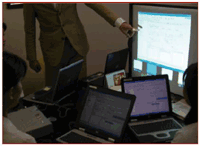


|
Orthodontics 660 Course Objectives The
Orthodontics 660 course is designed to provide the 6th year student
with both clinical instruction and experience in orthodontics. Diagnostic
skills developed will enable the student to evaluate the severity
of malocclusions and the degree of treatment difficulty before starting
the treatment, and clinical experience earned will make possible
for a student to carry out orthodontic treatment a general practitioner
could handle. Practical
training in diagnoses Since making a diagnosis is not only an intellectual work process which requires advanced professional knowledge, but also an oral health expert's daily work, the Department provides the student with training where s/he has a postulated (virtual) experience of making a diagnostic judgment and inference process with the use of a computer-based intelligence system that has the student clearly understand the "diagnostic process by an oral health expert." The Department also uses a new group study method with wireless projectors, aiming for effective training results -Purposes
of practical training in diagnoses The
first case: Case of anterior crossbite on a growth phase [Clinic for Patient Care] The
student is requested to participate in a seminar for diagnosing
and treatment planning of a new patient with malocclusion. @ |
|
|
Recommendations |
|
